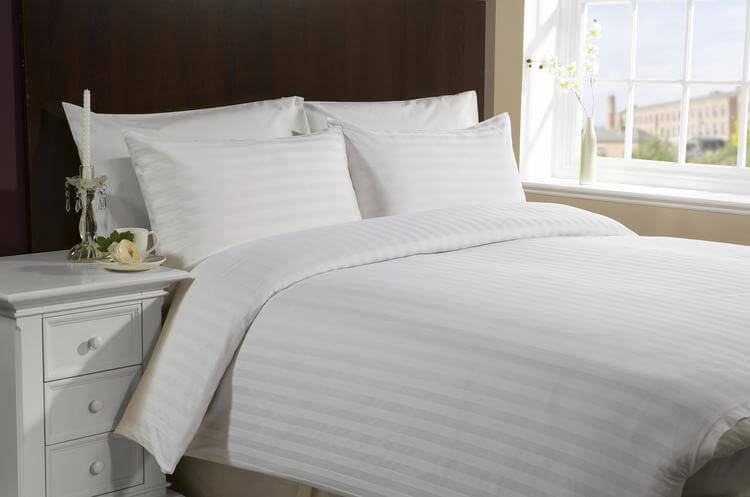TOP 7 best bed linen materials: 2024-2025 quality ranking
 For the right choice of quality material for bed linen, it is important to know all the advantages and disadvantages of each option.
For the right choice of quality material for bed linen, it is important to know all the advantages and disadvantages of each option.
Only fully studied information will allow you to make a purchase with which you will be satisfied not even for months, but for years.
Rating of the best materials for bed linen
| Place | Name | Price | Rating |
|---|---|---|---|
| The best bed linen material by price/quality for 2024-2025 | |||
| 1 | Coarse calico | Ask for a price | 9.9 / 10 |
| 2 | Mako satin | Ask for a price | 9.8 / 10 |
| 3 | Percale | Ask for a price | 9.8 / 10 |
| 4 | Poplin | Ask for a price | 9.7 / 10 |
| 5 | satin | Ask for a price | 9.6 / 10 |
| 6 | Satin suite | Ask for a price | 9.4 / 10 |
| 7 | Stripe satin | Ask for a price | 9.3 / 10 |
Content
How to choose the material for bed linen in the price / quality ratio?
Sleep is the key to health. And quality sleep depends in part on bedding: a mattress, pillows and blankets. The bedding we sleep on is also important. Therefore, his choice should be approached with all seriousness.
Let's figure out what to look for when choosing a material for bed linen.
Density
One of the important parameters on which the wear resistance and quality of the entire bed depends. The density value indicates how many threads are contained in one square meter of fabric. A higher value will ensure continued use of the fabric.
There is a special classification of material densities (values are indicated per 1 square centimeter):
- low - 25-35 (batiste);
- below average - 35-60 (coarse calico);
- average - 51-64 (linen);
- above average - 65-94 (Turkish silk);
- high - 95-200 (satin or poplin);
- very high - over 200 (Japanese silk, percale).
Unfortunately, the manufacturer rarely indicates this data on the label, so these indicators are best remembered before going to the store.
tailoring quality
You need to pay attention not only to the material, but also to the quality of tailoring this fabric, since the manufacturer can spoil even excellent material with poor-quality processing.
If large parts of the bed (sheet, duvet cover) are sewn from several parts, they will not last long.
It is important to inspect the seams - they should be even, and the edges neatly processed.
All material must be stitched with a special linen seam, in which the cuts are completely hidden. This will prevent fraying of materials.
Package
On the label, the manufacturer must indicate information about the material used, as well as recommendations for its care and use.
It is worth paying attention not only to the information contained, but also to the design of the label: whether the text is smeared, whether there are grammatical errors.
A manufacturer that cares about its reputation will not allow such blunders.
Smell and paint
The quality of the paint can be understood even by the smell of the material: it should smell like textiles, not chemicals. The smell of chemistry and mold signal a low grade of dye. Such material quickly fades, and besides, it can stain the skin and cause allergic reactions.
The quality of the paints used can be checked even when buying a fabric - rub it with your palm or a dry cotton pad.
The wrong side of the material should be almost as bright as the front.If the difference between them is significant, then the paint is applied superficially and will soon be erased.
The label should indicate the maximum allowable temperature for washing bedding. If it is 60 degrees or higher, then the paint used is of high quality.
The best bed linen material by price/quality for 2024-2025
We will describe the best materials that can be used for sewing bed linen.
Coarse calico
Production begins with the manufacture of an ordinary white calico cloth, and then on it 
This bed linen consists entirely of natural cotton fibers..
In the manufacture of fabrics, ordinary plain weaving is used, which greatly facilitates the production process and makes fabrics affordable.
Pure white calico is used more often than other fabrics for the manufacture of bedding for hospitals and medical boarding schools.
The cotton composition and the simple weaving of the threads provide an excellent imposition of colors and their brightness. Coarse calico with a pattern is no longer called bleached, but printed. The durability of the picture depends on the quality of the paint.
Coarse calico is divided into types according to density:
- 100 gr/sq.m - the cheapest option. It is better to use such coarse calico for a guest bed or a summer cottage. In daily use, it will not last long.
- 125 gr/sq.m - Most manufacturers make fabric from coarse calico of exactly this density. This bed has the best value for money.
- 140 gr/sq.m - elite calico, with which nothing will happen even after 100 washes.
pros
- Low cost. A simple weaving method facilitates the production process, making the material cheaper than satin or poplin.
- Naturalness.In its composition, the fabric has only natural fabrics.
- High wear resistance. Moreover, the higher the density, the longer the calico will last.
- Hygroscopicity. Calico is ideal for people suffering from excessive sweating due to its excellent moisture absorption.
- Hypoallergenic. The composition of the calico does not contain components that would cause an allergic reaction.
- Saturation of drawings. The paint adheres well to the calico. Moreover, the brightness is maintained for a long time.
Minuses
- Shrinkage. After the first wash, the calico bed sheet may shrink. But this can be avoided if you buy a fabric with a high density.
- Long dry. Due to the good absorption of moisture, the fabric dries for a long time.
Mako satin
It is from mako-satin that bed linen with three-dimensional drawings is made (in 2021 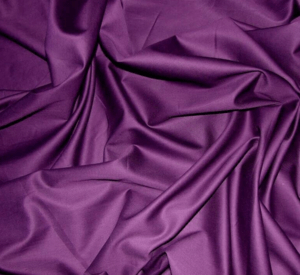
This fabric is made from the highest quality cotton.. The material has a pleasant tactile properties and a characteristic sheen.
In the textile industry, mako-satin is preferred only by the most upscale manufacturers: usually, elite lines of bed linen are produced from this material.
pros
- High wear resistance and strength. With proper care, mako-satin does not lose its properties for more than 10 years.
- Natural composition. Mako-satin is made only from cotton fibers.
- No electrification.
- Drawing volumetric drawings. The special long-fibre structure provides a three-dimensional design. No other material can achieve this effect.
- No shrinkage. Even after numerous washes, mako-satin does not shrink.
Minuses
- The main disadvantage of mako-satin is its high cost.However, having once paid a good amount, you can get high-quality and pleasant to the touch bed linen.
Percale
At the moment, the main purpose of percale is the manufacture of bed linen. 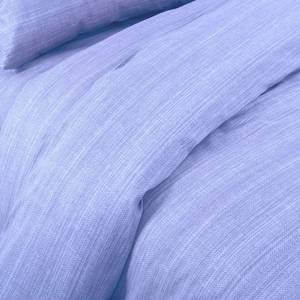
Percale fabric has long won the love of manufacturers and buyers. The main characteristic of percale fabric is a special weaving, which ensures its wear resistance and increased strength.
The correct production of percale is based on the use of exclusively natural fibers.
Unscrupulous manufacturers may pass off the addition of synthetic fibers as a fabric advantage, but this is far from the case.
Percale can be plain or printed.
pros
- Wear resistance. Percale bed linen just doesn't get demolished.
- Price. The cost of percale is approximately on a par with poplin and an order of magnitude cheaper than satin.
- Antistatic. Bed linen made of natural cotton does not accumulate static.
- Unpretentiousness in care. No additional steps other than washing and ironing are required.
- Good moisture absorption.
- Minimum shrinkage, which is ensured by a special dense weave of fibers.
Minuses
- Like many other cotton materials, percale takes a long time to dry. This should be taken into account if you want to wash your bedding in the morning and put it back on in the evening.
Poplin
Falling asleep on such linen, one feels only relaxation and complete comfort. Bedding 
The fabric is pleasant and soft to the touch.
Poplin is also a cotton fabric, which is distinguished by a special weaving of fibers. Sometimes the manufacturer may also use artificial fibers for weaving. You can't say it's always bad.
If synthetic materials are chosen correctly, then such poplin is of high quality and pleasant tactile sensations.
pros
- Ease of care.
- Soft and pleasant to the touch.
- Excellent air permeability.
- Durability and strength.
- Almost does not wrinkle.
- Dries quickly.
- Suitable even for allergy sufferers.
- Can be used at any time of the year.
- Affordable cost.
- Paint adheres well.
Minuses
- Shrinks 10% when washed.
satin
The sheen of satin is rightfully compared to silk overflows.. Yes, and on the main 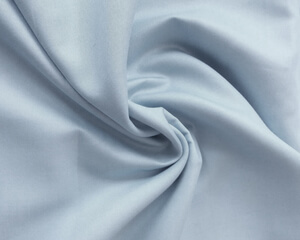
The raw material for the manufacture of satin is also natural cotton.. A particularly valuable satin is one that is made from elongated fibers (Egyptian cotton).
Satin will last a long time. But when using it, you should follow some simple recommendations.
For example, the fabric is not dried in direct sunlight, even when turned inside out.
pros
- Durability and strength.
- Nice shine.
- Gentle to the touch, soft.
- Provides free air circulation.
- Only safe materials are used for staining.
- Hypoallergenic composition.
- It does not deform during washing and does not shed.
- Provides comfort and relaxation during sleep.
Minuses
- More suitable for summer sleep than for winter.
- Requires special care.
- High price.
Satin suite
Luxe satin is an improved version of regular satin, which has a higher 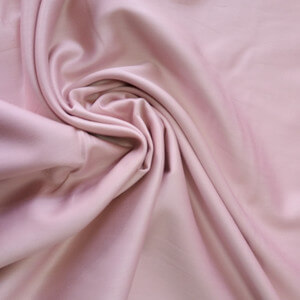
The material is moderately dense, pleasant to the touch and soft. Satin-lux keeps its shape perfectly even after prolonged use.
The front side is characterized by silkiness and shine.
Often, luxury satin is dyed in one color, but there are also printed or printed options. Only the densest fibers of medium length are used to make the fabric.
During the production process, they are polished to perfect smoothness and shine.
pros
- Security and softness.
- Naturalness.
- Hygroscopicity.
- Hypoallergenic.
- Able to warm in the cold and cool in the heat.
- Attractive appearance.
- It holds its shape well during sleep and washing.
- Resistant to pilling and color fading.
Minuses
- Shrinks when washed in hot water.
- High price.
- Sensitivity to ultraviolet light.
Stripe satin
Stripe satin in its characteristics resembles an expensive jacquard: it is the same 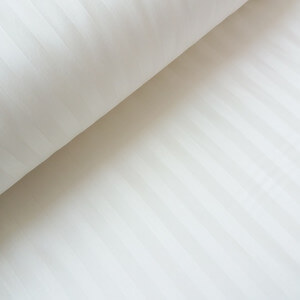
Moreover, the stripes are obtained not by dyeing, but due to the special interweaving of fibers of various shades. Compared to jacquard, whose colors are dominated by flowers and abstraction, stripe satin looks more restrained and calm.
The color scheme of the material is also usually pastel - it can be peach, pale pink, pistachio, milk, champagne, coffee or chocolate.
The threads are dyed only with the highest quality paints, so the material retains the saturation of shades for a long time.
pros
- Hypoallergenic.
- Natural composition.
- High strength.
- No electrolysis.
- Pleasant tactile sensations.
- Ease of maintenance.
Minuses
- High price.
Which firm to choose?
Here is a rating of the best domestic manufacturers of bed linen:
- Monolith;
- ArtBed;
- Vasilisa;
- Slept Spalych;
- Verossa;
- Cotton Paradise;
- Kazanov.A;
- Cotton Dreams;
- Ecotex;
- Owl and lark.
Conclusion
All described materials are characterized by high strength, naturalness and pleasant tactile properties. The only difference is in the colors and cost.
Customer Reviews
Useful video
From the video you will get acquainted with an overview of the best materials for bed linen:



